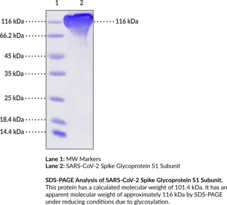Territorial Availability: Available through Bertin Technologies only in France
- Correlated keywords
- anti-viral SARS-CoV-2 SARSCoV2 covid-19 covid19 coronavirus corona virus 2019nCoV glyco-protein S1RBD S1RBP CoV2 HEK-293 ACE-2 MERSCoV
- Product Overview:
Severe acute respiratory syndrome coronavirus 2 (SARS-CoV-2) surface glycoprotein, also known as the spike glycoprotein, is encoded by the S gene in SARS-CoV-2 RNA.{53462} SARS-CoV-2 is a member of the Betacoronavirus genus of viruses that has an approximately 79% sequence identity with SARS-CoV.{53459,53461} The spike protein of SARS-CoV-2 and the related viruses SARS-CoV and Middle East respiratory syndrome coronavirus (MERS-CoV) is a transmembrane glycoprotein that assembles into homotrimers on the virus surface and is comprised of an N-terminal S1 subunit, which contains the receptor binding domain (RBD), and a C-terminal S2 subunit, which facilitates fusion between viral and host cell membranes.{46767,46768,49561} The 193-amino acid RBD of the SARS-CoV spike protein is a target for neutralizing antibodies.{46768,49525} The SARS-CoV-2 RBD, which spans amino acid residues 329 to 521, is 73% identical to that of SARS-CoV and can bind to human angiotensin-converting enzyme 2 (ACE2), which is the host cell surface receptor for both SARS-CoV and SARS-CoV-2.{46767,46768, 49561,49525} SARS-CoV-2 is the causative agent of COVID-19, a primarily respiratory illness characterized by fever, cough, and shortness of breath that can lead to life-threatening complications.{53461,55257,55258} Cayman’s SARS-CoV-2 Surface Glycoprotein S1 Subunit can be used for ELISA. This protein is a disulfide-linked homodimer. The reduced monomer, comprised of the SARS-CoV-2 surface glycoprotein S1 subunit (amino acids 16-685) fused to mouse IgG1 Fc at its C-terminus, consists of 904 amino acids and has a calculated molecular weight of 101.4 kDa. As a result of glycosylation, the monomer migrates at approximately 116 kDa by SDS-PAGE under reducing conditions.
Cayman Chemical’s mission is to help make research possible by supplying scientists worldwide with the basic research tools necessary for advancing human and animal health. Our utmost commitment to healthcare researchers is to offer the highest quality products with an affordable pricing policy.
Our scientists are experts in the synthesis, purification, and characterization of biochemicals ranging from small drug-like heterocycles to complex biolipids, fatty acids, and many others. We are also highly skilled in all aspects of assay and antibody development, protein expression, crystallization, and structure determination.
Over the past thirty years, Cayman developed a deep knowledge base in lipid biochemistry, including research involving the arachidonic acid cascade, inositol phosphates, and cannabinoids. This knowledge enabled the production of reagents of exceptional quality for cancer, oxidative injury, epigenetics, neuroscience, inflammation, metabolism, and many additional lines of research.
Our organic and analytical chemists specialize in the rapid development of manufacturing processes and analytical methods to carry out clinical and commercial GMP-API production. Pre-clinical drug discovery efforts are currently underway in the areas of bone restoration and repair, muscular dystrophy, oncology, and inflammation. A separate group of Ph.D.-level scientists are dedicated to offering Hit-to-Lead Discovery and Profiling Services for epigenetic targets. Our knowledgeable chemists can be contracted to perform complete sample analysis for analytes measured by the majority of our assays. We also offer a wide range of analytical services using LC-MS/MS, HPLC, GC, and many other techniques.
Accreditations
ISO/IEC 17025:2005
ISO Guide 34:2009
Cayman is a leader in the field of emerging drugs of abuse, providing high-purity Schedule I-V Controlled Substances to federally-licensed laboratories and qualified academic research institutions for forensic analyses. We are certified by ACLASS Accreditation Services with dual accreditation to ISO/IEC 17025:2005 and ISO Guide 34:2009.





